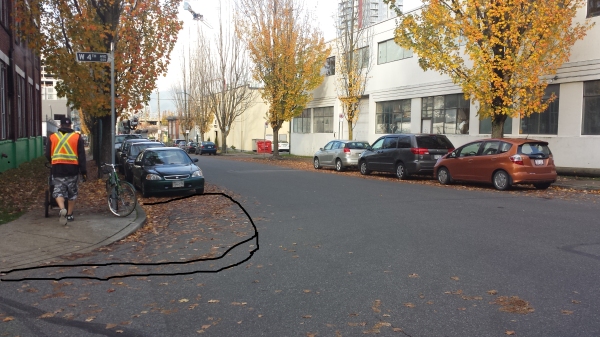
Snow Shows Where Cars Actually Travel
Inspired by Streetsfilms, I previously wrote a photo-journal showing how snow reveal how much space cars actually need. Streetsfilms inspired me to do this again, but this time with fall leaves. I branched out from the West End this time, but the conclusion is the same. We sacrifice too much of our precious and valuable city public land for automobiles, but they don’t even use it. It is incredible that we are misallocating space for vehicles, especially considering how expensive it is to build and maintain asphalt. According to the Victoria Transport Policy Institute it costs $2,257,440/km for a 3 meter road lane but only $251,200/km for a 1.5 meter sidewalk. We are spending 5X the cost on space that doesn’t serve any purpose or create any value. It is time we start reclaiming valuable public land for a better return on investment of public expenses and your tax dollars.
According to this study of pedestrian-vehicular collisions in Vancouver, 75% occur at the intersection. We could reclaim valuable public land that is being dedicated but not used by automobiles, and install corner bulges to “pinch” the intersection. Since bulges reduce the crossing distance and tighten up the turning radius forcing vehicles to slow down, this will help reduce collisions. Reduced injuries and fatalities translates into in reduced healthcare and policing. Providing safer streets would also encourage more people to walk which can reduce the billions in tax dollars spent on healthcare nationally due to increasingly sedentary lifestyles.
This intersection in Strathcona shows there is unused space that could be converted to a bulge out to reduce the crossing distances.
There was a nearby bulge out that provided a nice example. Notice how there are fewer leaves by this intersection. This space is being used more efficiently.
Here are some other examples, by city hall.
There are plenty of examples in the industrial/office area near Broadway which is notorious for its lack of lighting and people driving through at dangerous speeds.
Wondering around Maple Tree Square in Gastown also reveals potential.
I would like to end with this photograph showing just how little space bicycles use. Re-allocating space for bicycles can get more out of less tax-dollars as you don’t need as much space to more more people.



















